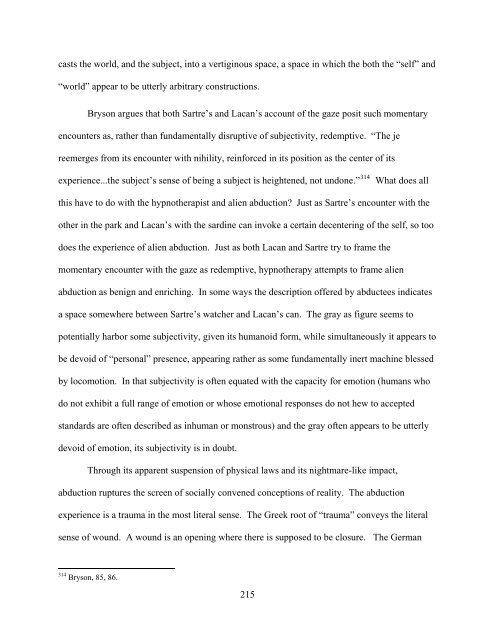A Genealogy of the Extraterrestrial in American Culture
A Genealogy of the Extraterrestrial in American Culture
A Genealogy of the Extraterrestrial in American Culture
You also want an ePaper? Increase the reach of your titles
YUMPU automatically turns print PDFs into web optimized ePapers that Google loves.
casts <strong>the</strong> world, and <strong>the</strong> subject, <strong>in</strong>to a vertig<strong>in</strong>ous space, a space <strong>in</strong> which <strong>the</strong> both <strong>the</strong> “self” and<br />
“world” appear to be utterly arbitrary constructions.<br />
Bryson argues that both Sartre’s and Lacan’s account <strong>of</strong> <strong>the</strong> gaze posit such momentary<br />
encounters as, ra<strong>the</strong>r than fundamentally disruptive <strong>of</strong> subjectivity, redemptive. “The je<br />
reemerges from its encounter with nihility, re<strong>in</strong>forced <strong>in</strong> its position as <strong>the</strong> center <strong>of</strong> its<br />
experience...<strong>the</strong> subject’s sense <strong>of</strong> be<strong>in</strong>g a subject is heightened, not undone.” 314<br />
What does all<br />
this have to do with <strong>the</strong> hypno<strong>the</strong>rapist and alien abduction? Just as Sartre’s encounter with <strong>the</strong><br />
o<strong>the</strong>r <strong>in</strong> <strong>the</strong> park and Lacan’s with <strong>the</strong> sard<strong>in</strong>e can <strong>in</strong>voke a certa<strong>in</strong> decenter<strong>in</strong>g <strong>of</strong> <strong>the</strong> self, so too<br />
does <strong>the</strong> experience <strong>of</strong> alien abduction. Just as both Lacan and Sartre try to frame <strong>the</strong><br />
momentary encounter with <strong>the</strong> gaze as redemptive, hypno<strong>the</strong>rapy attempts to frame alien<br />
abduction as benign and enrich<strong>in</strong>g. In some ways <strong>the</strong> description <strong>of</strong>fered by abductees <strong>in</strong>dicates<br />
a space somewhere between Sartre’s watcher and Lacan’s can. The gray as figure seems to<br />
potentially harbor some subjectivity, given its humanoid form, while simultaneously it appears to<br />
be devoid <strong>of</strong> “personal” presence, appear<strong>in</strong>g ra<strong>the</strong>r as some fundamentally <strong>in</strong>ert mach<strong>in</strong>e blessed<br />
by locomotion. In that subjectivity is <strong>of</strong>ten equated with <strong>the</strong> capacity for emotion (humans who<br />
do not exhibit a full range <strong>of</strong> emotion or whose emotional responses do not hew to accepted<br />
standards are <strong>of</strong>ten described as <strong>in</strong>human or monstrous) and <strong>the</strong> gray <strong>of</strong>ten appears to be utterly<br />
devoid <strong>of</strong> emotion, its subjectivity is <strong>in</strong> doubt.<br />
Through its apparent suspension <strong>of</strong> physical laws and its nightmare-like impact,<br />
abduction ruptures <strong>the</strong> screen <strong>of</strong> socially convened conceptions <strong>of</strong> reality. The abduction<br />
experience is a trauma <strong>in</strong> <strong>the</strong> most literal sense. The Greek root <strong>of</strong> “trauma” conveys <strong>the</strong> literal<br />
sense <strong>of</strong> wound. A wound is an open<strong>in</strong>g where <strong>the</strong>re is supposed to be closure. The German<br />
314 Bryson, 85, 86.<br />
215















